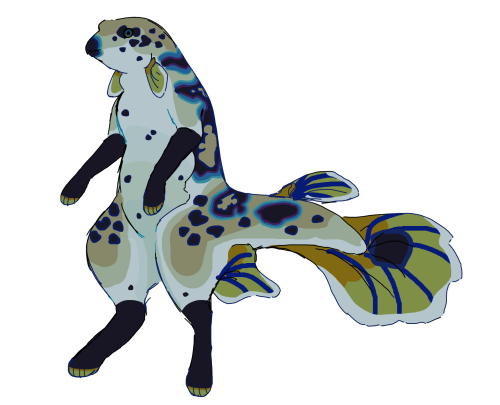
Thylacine archive blog: @moonlight-wolf-archive
204 posts
Latest Posts by rhincodon-cynocephalus - Page 4



headworld protag redesign junk… read more for even more junk!
Keep reading
Reblogging this again, I'm very proud of this.
Might become a sticker design

Halloween art piece:)
Enjoy
Also if you understand the tombstones, kudos!!!!
Whaler Sharks


a thylacine on kunanyi/mt wellington
The male pufferfish tries to impress potential mates with his masterpiece. Source: BBC Earth

Halloween art piece:)
Enjoy
Also if you understand the tombstones, kudos!!!!
Something’s fishy 🐟🐠

Meet the largest family of living sharks today—deep-sea catsharks.
Deep-sea catsharks are the largest family of living sharks today, with more than 90 species. Catsharks were named for their long, cat-like eyes that are specialized for seeing in low light conditions. These a-meow-zing sharks can be found up to 2,200 meters (7,200 feet) below the surface and grow up to 75 centimeters (30 inches).

MBARI has observed several deep-sea catshark species, for example, the brown catshark (Apristurus brunneus), longnose catshark (Apristurus kampae), lollipop catshark (Cephalurus cephalus), and filetail catshark (Parmaturus xaniurus). Most catsharks lay elaborate clusters of egg cases. The eggs can take up to two years to develop. Tough egg cases, made of keratin protect the developing embryos from predators. A changing ocean means an uncertain future for catsharks. Warming waters could affect developing embryos, and expanding low-oxygen zones could displace adult populations.

Wet specimen of a baiji calf (Lipotes vexillifer).
The gestation period for this species lasted 10-11 months. Calves measured around 80–90 centimetres (31–35 in) at birth, and nursed for 8–20 months. [x]


The Sicilian wolf (Canis lupus cristaldii) was a subspecies of gray wolf, slightly smaller in size than the extant Italian wolf. Accused of killing livestock, it was hunted extensively and likely became extinct by the 1930′s, though sightings persisted for several decades.
A single image exists of a live Sicilian wolf, taken in the late 1800s. It shows a captive animal on a chain.
The second image above is the holotype specimen, which is located at the Museo di Storia Naturale, University of Florence.
A handful of specimens exist, all located in Italian museums. The taxidermy specimen below (from Museo Regionale Interdisciplinare di Terrasini, Palermo, Italy) illustrates the wolf’s image as a sheep killer. [x]


Adult and juvenile vaquita (Phocoena sinus) skeletons displayed at Museo Laberinto de las Ciencias in San Luis Potosí, Mexico. [x]
Rare footage of an Eastern black rhinoceros [ Diceros bicornis michaeli ] and her calf, taken in the 1950s in Amboseli National Park, Kenya. The rhino, known as “Gertie”, had a horn that measured nearly 4ft in length before breaking off naturally sometime in the 1960s, possibly during a fight with another rhino.
The demand for rhinoceros horn has made sights such as this exceedingly rare. As of 1992, only 2 rhinos were left in Amboseli National Park, where the animal is now considered locally extinct, while the subspecies as a whole is listed as critically endangered.
[ video source ]

Sharktember: Big Mouth Squad (and yet they eat the smallest things in the ocean)
Beautiful!!!!!


Long time no tumblr!

Taonius borealis: Bizarre Deep-sea Squid with Snooki Hair and Giant WALL-E eyes!
Weird Looking Animals

Red river hog (Potamochoerus porcus)
@ unknown

🔥 Rhincodon typus using its filter feeding strategy to create a vortex near the surface and have an easy dinner.
"whoops, S.H.U.S.H will take care of it."
darkwing duck never accepted responsibility for the fact that he killed bud flood


behold: 🐡
Wild Stingrays making sounds beneath the waves
Stingrays: no longer the silent residents of the sea!
Our new Journal of Ecology paper provides the first evidence of not one but TWO species of #stingray actively producing sounds 🔊
https://doi.org/10.1002/ecy.3812
We present 3 examples of sound production by wild stingrays - one of an adult mangrove whipray (Urogymnus granulatus) in #Indonesia by #scuba diver Philip Christoff, a juvenile mangrove whipray at #MagneticIsland in the #GreatBarrierReef by biologist and photographer Javier Delgado Esteban, and an adult cowtail stingray (Pastinachus ater) at #HeronIsland the Great Barrier Reef by marine biologist and photographer Johnny Gaskell.
The sounds are characterised by short, sharp ‘clicks’ and likely serve as a warning or defence signal. Both species often form large groups, so it may alert others to potential danger, suggesting a role in intraspecific communication! The mechanism is still unclear 🤔 but it appears they are produced through rapid movement of the jaw or head and spiracles behind the eye.
Almost 990 species of bony #fish have been shown to actively produce sounds, but until now #elasmobranchs (sharks, rays, and skates) have been considered silent. We show that this is a misconception, and more #research into this ability is needed! Turns out we have much to learn about life beneath the waves…
Given these observations were captured opportunistically by different people, we expect more to come to light in these and possibly by other species. If you’ve seen something similar, please get in touch!
The paper is fairly short and you don’t need specialist skills to understand most of it, so do take a read & let us know what you think 👍.
The early view pre-typesetting version is up now here:
https://doi.org/10.1002/ecy.3812
(all versions will be open access and free to read)

Prey Animals. Written by Nathan Aaseng. Illustrated by Alcuin Dornisch. 1987.
Doctors be like


Weapon fairy no.8
Rosy maple moth, amaranth, spiked club

So goofy



Noguchi Yukoku (1825 - 1898)









parts 1-2